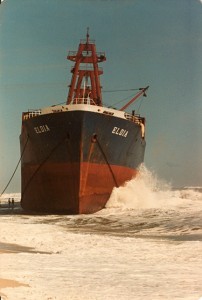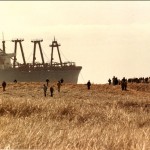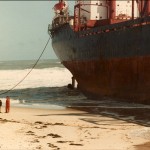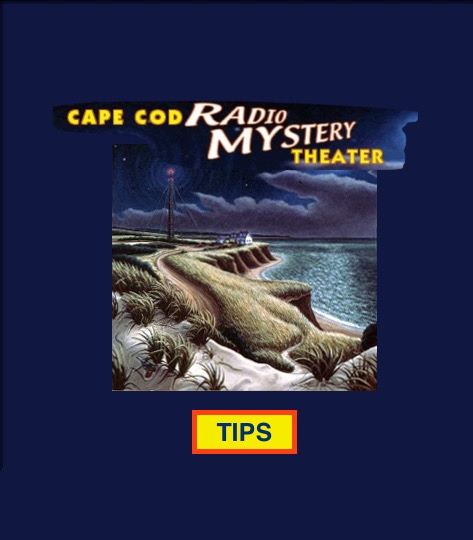Posted in Liner Notes, What's New
‘THE CURSE OF THE WHALE’S TOOTH’
Recorded at: HT Recording Studio, Dennis, Cape Cod
Play’s location: Cape Cod National Seashore, Captain Penniman House in Eastham and Truro Highlands
First broadcast: ?
Cast: First Mate . . . . . . . . . . . . . Jeff Camish
Ship Captain . . . . Bob Gianferante
Announcer . . . . . . . . . . Bob Nolan
Doctor Alexander Scofield . . . Wally O’Hara
Professor Roger Penniman . . . George McConville *
Captain Waverly Underhill . . . Dave Ellsworth
Priscilla Penniman . . . . . . Lee Olive
Gardener . . . . . . . . . . . . . . . Jeff Camish
Wendell Johnson, Park Ranger . . Neil McGarry
Nora Penniman . . . . . . . . . . . Kristy Weimar *
Director . . . . . . . . . . . . . . . . . Kevin Groppe
Assistant to the Director . . . . Scott Dickie
(*) First appearance in a CCRMT program
Author’s Notes and Recollections:
For radio mystery #6 it was back to John Todd’s studio and a return to the duo of Captain Underhill and Doctor Scofield.
With some mysteries it is hard to identify the genesis of the original idea, but with ‘Whale’s Tooth’ it’s simple. The idea arose out of a desire to attempt a gothic-style radio mystery (i.e. one heavy on atmosphere and location, — plenty of murk and moonlight—as well as a constant sense of ill-ease and foreboding overspreading everything). Sir Arthur Conan Doyle’s “Hound of the Baskerville’s” is the considered the archetypal classic.
This latent desire remained dormant until the winter of 1981, then started to germinate as I began reading articles in the Cape Cod Times, The Register and other Cape newspapers, reporting several quasi-verified sightings of a lion-sized cat roaming the Truro Highlands. 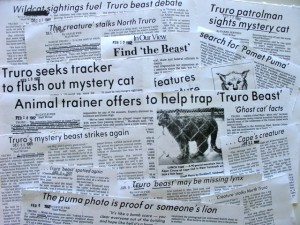
(Photos by Peter Whittier)
What a striking, visual oddity it presented, this towering, monstrosity of steel and superstructure lounging on the very same sandy beach where sunbathers came to lie on towels in the sun. It got me thinking about the ancient custom of Mooncussing, the legendary practice of deliberately luring a ship onto a shoal for the purpose of pillaging its cargo. Authorial research demanded a trip to view the wreck, as well as several additional fun treks to scout the picaresque locales in Truro, mostly along the Pamet River Road, especially the magnificent hill, –I forget it’s name—that overlooks Ballston Beach with Higgins Hollow Road winding around it’s base. Another location borrowed for the story was the Penniman House, an authentic and ornate sea captain’s house located on Fort Hill Road in Eastham overlooking the estuaries of Salt Pond Bay. The house has the jaw of a Sperm whale framing its front sidewalk. (All these locations are recommended visiting!) Captain Penniman, the real Captain Penniman, was a whaling captain whom my wife is semi-distantly related to. Whether the real historical figure bore any resemblance to the fearsome and nefarious Jacob Penniman of the story is not being asserted. (Whether my wife does too is not being broached.)
Dialogue was recorded at John Todd’s garage studio in Dennis. Recording sessions often started at 7 in the evening, but sometimes at 5 or even 3, and often went on until 1 or 2 in the morning. Sessions were arranged around John Todd’s always frenetic schedule, as he was not only running his demo studio, but was a high school music teacher and played in a group called The Trio. Both John and Scott, being professional musicians, were accustomed to being night owls. I, however, as more of the lark-of-the-morning type, remember struggling to drive home from these sometimes mind-numbing marathons. One thing I learned, you never appreciate how many feral cats there are on Cape Cod until you drive down the Old Kings Highway in the wee, wee hours and see them scampering across the road, seems like hundreds. (Say? Could that be the seed for a sequel: Gangs of formerly domestic cats banding together to attack humans like schools of piranha fish?)
The cast features many fun voices from earlier productions: Not only Dave and Wally, who were really starting to settle into their rolls, but Bob Nolan, Lee Olive, Bob Gianferante, Jeff Camish, Neil McGarry. Particularly memorable to me is that this show marks the first appearance of George McConville in a CCRMT production. Cast as the harried Roger Penniman in the story, Mr. McConville was already an accomplished actor known to many theatergoers on the Cape. He was especially active at the Harwich Junior Theater in Harwichport. George had a warm, highly listenable, narration-style voice that was good at conveying feelings of dread and other plaintive qualities (which he later put to good use in ‘The Buoy’.)
I remember this as a fun production: John Todd running the mixing board and having to rewind and reset the 8 track, every time I yelled cut, when a mistake was made or the performances weren’t right. In these early days multiple takes were not done. The show was recorded in one continuous take, from beginning to end, with many starts and stops along the way. This show has a lot of Scott Dickie’s imprimatur on it too. After the dialogue was finished, he and I met daily at his rented cottage studio off Old King’s Highway, located roughly behind the Dennis Playhouse, (now the Cape Cod Playhouse) where we spent two weeks recording out-of-doors as well as banging and tapping on objects in his cottage to record the raw sound effects which we later layered in at John’s. Scott also provided the evocative black and white drawing accompanying the mystery and also contributed a snippet of his rock song, ‘Test Tube Babies’ which the truculent Nora Pennimen is listening to in her bedroom when Underhill arrives to question her.
I’m partial to Mark Birmingham’s score on this one too. It does a nice job of conjuring up and maintaining just the right sense of foreboding that gothic mysteries call for. The instrumentation he chose too has a transparency that both supports the story and enhances the suspense, without getting in the way.
Another newcomer, Kristie Weimar, played the part of the teenage delinquent, Nora Pennimen. Kristie, a Sandwich high student at the time, answered an audition call. I remember that on her way to the studio, she was involved in a minor automobile accent and showed up with a bump and a gash on her forehead, but gave a great performance anyway. Kristie has an ideal voice for radio, made evident, after college, when she spring-boarded into a broadcasting career working as on-air talent in Indianapolis, New Bedford, Baltimore, and Boston, and became a top-rated voice in the New York City market as host of the syndicated ‘All Nite Café’. Her sexy, mellifluous voice was familiar to listeners all across Europe on the Voice of America, as well on more than 40 radio stations across the U.S. In one of her scenes as Nora Penniman, Kristie provides a soft whimpering accompaniment to herself as she retells a nightmarish dream she had involving a lion. It has an erotic tinge to it that wasn’t fully appreciated until after the program came out. (I’ve been trying to get my wife to make those sounds for years). It might be part of the reason ‘Whale’s Tooth’ was voted by fans, at least during a stretch of the ‘90’s, as their second favorite show (behind ‘The Caller on Line One’).
The striking visual oddity of this monstrosity no longer afloat but resting on the beach like a sunbather on a towel got me thinking about the ancient custom of Mooncussing, the legendary practice of deliberately luring a ship onto a shoal for the purpose of pillage and salvage. Authorial research demanded a trip down to view the wreck, as well as several fun treks to scout the picaresque locales in Truro, mostly along the Pamet River Road, especially the magnificent hill, –I forget it’s name—that overlooks Ballston Beach with Higgins Hollow Road winding around it’s base. Another location borrowed for the story was the Penniman House, on Fort Hill Road in Eastham overlooking the estuaries of Salt Pond Bay, which had the jaw of a Sperm whale arching over its outer walkway. All locations worth visiting. The Peniman House is an authentic and ornate sea captain’s house once belonging to Captain Penniman, a real whaling captain whom my wife is distantly related to. Whether the historical whaling captain was a Mooncusser or bares any resemblance to nefarious Jacob Penniman of the story is not claimed, (whether my wife does as well is a subject not to be broached)
The dialogue was recorded at John Todd’s garage studio in Dennis. Recording sessions usually started at 7, but sometimes 3 or 5, and often went on until 1 or 2 in the morning. Sessions were booked around John Todd’s hectic schedule, as he was not only running a studio, but was a high school music teacher and played in a group called The Trio. Both John and Scott being professional musicians were accustomed to being night owls. I, as more of a lark of the morning, remember struggling to drive home from those mind-numbing marathons.
The cast features many fun voices from earlier productions: Not only Dave and Wally but Bob Nolan, Lee Olive, Bob Gianferante, Jeff Camish, Neil McGarry, and is particularly memorable as marking the first appearance of George McConville in a CCRMT production. Cast as Roger Penniman, George McConville was already an accomplished actor known to many theatergoers on the Cape. George was particularly active at the Harwich Junior Theater in Harwichport. George had a warm and listenable narrative voice that was good at conveying a feeling of dread along with a plaintive quality (which he was later to turn to good effect in ‘The Buoy’.)
This recording has a lot of Scott Dickie’s imprimatur on it. After recording the dialogue at John’s, he and I spent two weeks at his rented cottage studio off Old King’s Highway, located roughly behind the Dennis Playhouse, where we spent two weeks banging and tapping on things and recording them to record the raw sound effects which we later layered in at John’s. Scott did the clever black and white drawing accompanying the story and also contributed a snippet of his rock song, ‘Test Tube Babies’ which the truculent Nora Pennimen is listening to in her bedroom when Underhill arrives to question her. The part of Nora Pennimen was played by another newcomer, Kristie Weimar. Kristie was a Sandwich high student who answered an audition call. She had a great voice, ideal for radio, which was evident as she spring boarded into broadcasting career working as on-air talent in Indianapolis, New Bedford, Baltimore, and Boston. She became a top-rated voice in the New York City market as host of the syndicated ‘All Nite Café’ and her sexy, mellifluous voice familiar to listeners across Europe over the Voice of America and on more than 40 radio stations across the Country. In ‘Whale’s Tooth’ as Nora Penniman, Kristie’s whimpering recounting of her nightmarish dream involving a lion had an erotic tinge to it that wasn’t fully appreciated until after the program came out. (I’ve been trying to get my wife to make those sounds for years), and it may be part of the reason ‘Whale’s Tooth’ was voted by fans, during the ‘90’s, as their second favorite show (behind ‘The Caller on Line One’).

